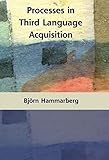Processes in Third Language Acquisition / Björn Hammarberg.
Material type: TextPublisher: Edinburgh : Edinburgh University Press, [2022]Copyright date: ©2009Description: 1 online resource (184 p.)Content type:
TextPublisher: Edinburgh : Edinburgh University Press, [2022]Copyright date: ©2009Description: 1 online resource (184 p.)Content type: - 9780748635115
- 9780748635122
- online - DeGruyter
| Item type | Current library | Call number | URL | Status | Notes | Barcode | |
|---|---|---|---|---|---|---|---|
 eBook
eBook
|
Biblioteca "Angelicum" Pont. Univ. S.Tommaso d'Aquino Nuvola online | online - DeGruyter (Browse shelf(Opens below)) | Online access | Not for loan (Accesso limitato) | Accesso per gli utenti autorizzati / Access for authorized users | (dgr)9780748635122 |
Frontmatter -- Contents -- Preface -- Acknowledgements -- List of tables -- Introduction -- Chapter 1 A study of third language acquisition -- Chapter 2 Language switches in L3 production: Implications for a polyglot speaking model -- Chapter 3 Re-setting the basis of articulation in the acquisition of new languages: A third language case study -- Chapter 4 The learner’s word acquisition attempts in conversation -- Chapter 5 Activation of L1 and L2 during production in L3: A comparison of two case studies -- Chapter 6 The factor ‘perceived crosslinguistic similarity’ in third language production: How does it work? -- Appendix 1: Key to transcription -- Appendix 2: SW’s narration of the picture story Hunden ‘The dog’ -- References -- Index
restricted access online access with authorization star
http://purl.org/coar/access_right/c_16ec
GBS_insertPreviewButtonPopup('ISBN:9780748635115);This volume brings together six case studies of an adult multilingual speaker who acquires a new language through social interaction. The book deals especially with the multilingual situation, the learner's acquisitional activities, and the involvement of background languages in the process of speaking. It offers a coherent study of various linguistic phenomena in one individual, including patterns and functions of language switching, word search in interaction, hypothetical construction of words, and articulatory settings in speaking. The main languages involved are English (L1), German (L2) and Swedish (L3). The activation of these languages in the learner's speech is examined in a cognitive perspective in relation to current models of the speaking process. A longitudinal corpus of NNS-NS conversations covering 21 months from the beginner stage provides the main data for these studies. Key FeaturesPresents an example of an active and purposeful language acquirerExplores cross-linguistic influence in a multilingual settingHighlights the significance of prior L2 knowledge in L3 performanceUseful for students and researchers interested in second and third language acquisition, individual multilingualism and the human speaking process. "
Mode of access: Internet via World Wide Web.
In English.
Description based on online resource; title from PDF title page (publisher's Web site, viewed 29. Jun 2022)


